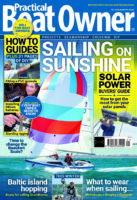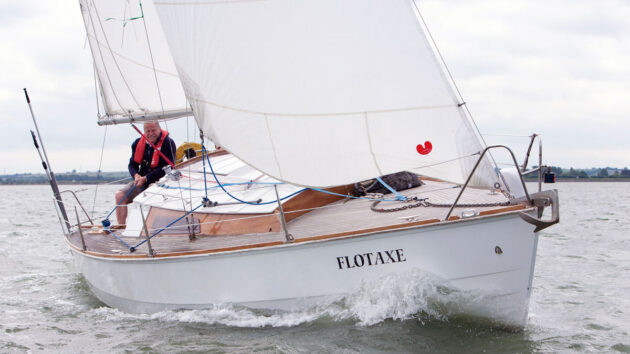From the popular Dutch range of plywood cruisers, the Waarschip 740 is a tough, fast and capable little yacht you can build at home. David Harding reports
Waarschip 740: the offshore boat you can build in your garage
Since launching in 1963, Waarschips has built more than 4,000 boats across the size range, from the original 600 and the Waarschip 740 up to the 12.6m (41ft) Waarschip 1220. There have been plenty of others in between, and they’re still being built today.
Best known in the UK is the 725, the quarter-tonner of which more than 1,000 were launched between 1968 (she originally raced in Class IV under the RORC rule) and 1976.
Like all Waarschips, the 725 was built from Bruynzeel plywood – a high-grade marine ply (‘Hechthout’ in Dutch) that was widely used by Van de Stadt in his early designs, including the all-conquering 73ft (22.25m) Stormvogel. Slightly larger than the Waarschip 725 was the 730.
With just three planking panels in each side of the hull, she was replaced in 1980 by the 740, whose five-plank construction gave her a more rounded appearance and made her easier on the eye.
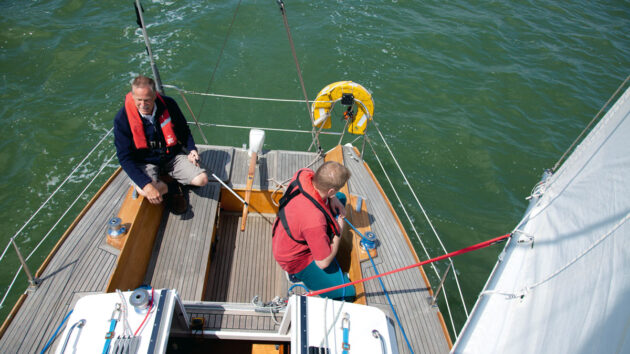
A well-designed cockpit on the Waarschip 740, with the seats well inboard, giving a good leg-bracing width between them and space outboard for the side decks to run all the way to the stern. Credit: David Harding
It’s a design that attracted the attention of Willem Bijl who, like most sailors in Holland, had seen a good number of Waarschips on the water.
He knew their reputation, so when the time came to buy a boat to build himself, it was an easy choice.
He bought the boat in 1993 as the empty hull, a large pile of wood and a slightly smaller pile of detailed plans, and set to work in the Waarschip shed in ‘t Waar that the company made available for owners completing their own boats.
Building was interrupted when Willem moved to the UK and had to find a house with a garage big enough to accommodate a yacht that’s 7.8m (25ft 8in) long with the sugar scoop.
It narrowed the choice down a bit, but he found somewhere, brought the hull and the rest of the wood over on a trailer, and carried on.
Waarschip as a company went through various changes during the course of the building before the boat was finally launched in 2007.
Surgical Precision of the Waarschip 740
Willem went about the project with the thoroughness and precision he applies in his professional life as a surgeon. He did everything himself, from the fitting out of the hull and construction of the deck to the installation of the engine and electrical systems.
With electrics being his hobby, he designed systems that, along with other practical solutions, ranged from a siphon-based fuel gauge to gimballed nav lights.
We will have a look at some of these later in this feature – but in the meantime, what of the boat itself? What is a Waarschip 740 like?
Many of us have seen Waarschips sailing in British waters or on our travels in northern Europe without knowing much about them except that they come from Holland and are built of plywood, so this was a good opportunity to get to know one.
Willem’s boat, Flotaxe (floating axe – there’s a story behind it), is a combination of the original Waarschip 740 and the Waarschip 740 Ocean, which Klaas Kremer developed as a souped-up version.
As well as being a designer, Kremer raced many of his and Akkerman’s designs, including the quarter-tonner that, as David Thomas ruefully recounts, deprived his Quarto of overall victory in the 1973 Quarter Ton Cup by protesting her out of the vital race.
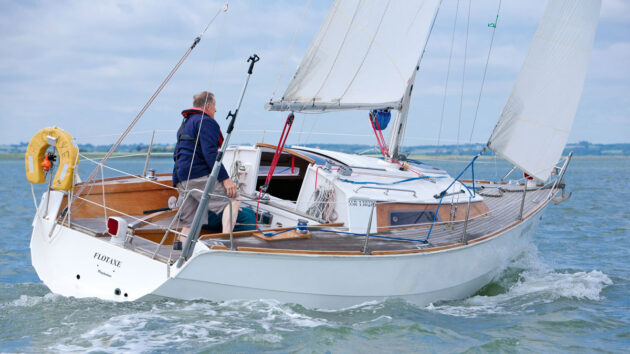
The sugar scoop draws out the stern
of the Waarschip 740 Ocean to make
her 7.8m (25ft 7in) long. Credit: David Harding
To create the Ocean version of the Waarschip 740, Kremer made the hull lighter, changed the keel from iron to lead, lowered the coachroof, raised the bridgedeck and added a sugar scoop to draw out the waterline, effectively bringing the transom-hung rudder inboard.
The other instantly recognisable change was the move from a masthead rig to a taller fractional alternative.
Flotaxe has the Ocean’s bridgedeck and sugar scoop, but Willem chose the original coachroof to give more headroom (a modest 5ft 4in/1.65m) and topped it with the masthead rig.
The result will look like a hybrid only to those with an intimate knowledge of the Waarschip 740, and it’s visually none the worse for incorporating elements of both versions.
Though perhaps lacking the grace of the early designs whose lines reflected the greater influence of Willem Akkerman, Kremer’s 740 is a nicely proportioned little ship that certainly does the business under sail.
That was obvious even within the confines of the Blackwater in a breeze of no more than 12-15 knots: she slipped along easily, leaving barely a ripple in her wake and exhibiting a poise and long-leggedness that would be the envy of many a self-proclaimed offshore cruiser 10ft longer.
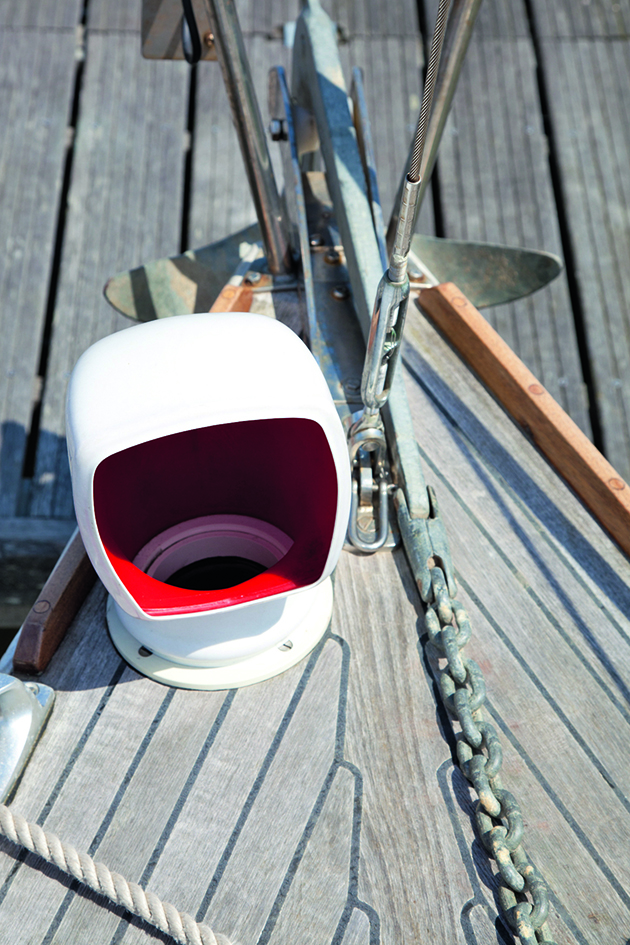
Vents at each end of the boat ensure a good through-flow of air down below. Credit: David Harding
Clocking high 5s on the log upwind, she was stiff, nicely balanced and beautifully responsive, with just the right amount of weight on the helm.
When you have a hull with a relatively narrow waterline in relation to the overall beam, plenty of ballast (close to 50% of the total weight), a good spread of sail and smooth, undistorted lines, this is the result: a boat that moves effortlessly, does what’s asked of her and makes you want to sail, do a bit of tweaking and carry on sailing.
The need to head back up the creek to our berth before it all turned to mud precluded much in the way of sail-tweaking, but there was doubtless more performance to be extracted from Flotaxe.
It would be interesting to know to what extent the three-bladed fixed propeller affected her. Willem reckons that, contrary to received wisdom, a prop creates less drag if it’s allowed to turn, so he leaves the engine in neutral.
Either way, it produces more drag than a folding or feathering alternative, but it also does a good job of converting the power of the single-cylinder Yanmar 1GM into forward thrust.
This was useful as we cut things a little tight with the tide, and the keel ploughed a furrow or two in the creek bottom on the way home.
Cockpits and Coamings on the Waarschip 740
It’s fundamental that a nicely responsive, tiller-steered boat should offer a good perch outboard for the helmsman.
Thankfully, the helming position on the Waarschip 740 is excellent.
Willem kept the coamings to little more than marginal upstands for the primary winches and the cleats, on the basis that it provides a stronger base for the winches to build this way than to mount them atop a higher coaming.
Asked whether green water flowing along the deck finds it easy to enter the cockpit as a result, he replies that the boat is so dry it’s not a problem.
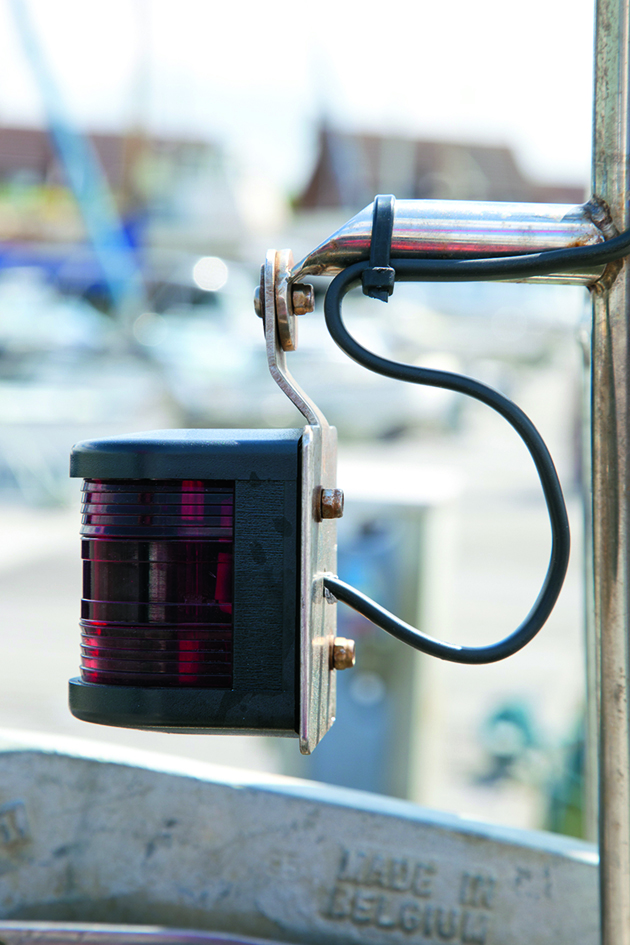
Gimballed nav lights don’t heel with the boat, making them easier to see. Credit: David Harding
For the same reason, he doesn’t have a sprayhood – and he’s certainly no fair-weather-only sailor.
Lockers in the stern, either side of the rudder stock and a mainsheet track across the bridgedeck complete the essentials in the cockpit, where Willem incorporated the fuel filler into the backrest outboard of the port seat behind an inspection hatch. It’s well protected from salt water and helps contain any drips of diesel.
Moving forward along the teak-covered decks, we find a coachroof that stops just ahead of the mast to leave a flush foredeck.
The coachroof’s transverse and fore-and-aft stiffening members are incorporated externally rather than internally, creating corners that inevitably make cleaning harder but provide secure footing when you need to work at the mast.
In the bow, Willem decided to forego the anchor locker.
He keeps the anchor rode in a bag just forward of the coachroof and uses the space where the locker would be to fit a vent. This way, with fresh air entering at the bow and another vent right aft, air is kept moving throughout the whole length of the boat.
Being of a practical bent and wary of avoidable complexity, Willem has refrained from fitting a roller-reefing system for the headsail. He uses the minimal-overlap genoa up to about 15 knots before changing to a working jib that’s 70% of the area and then dropping a slab in the mainsail.
Despite normally sailing short-handed and often on his own, he does not have an autopilot. If he needs to leave the helm, he heaves to, or takes all the drive out of the mainsail and leaves the boat to sail herself.
Below Decks
While well-finished GRP, steel or aluminium boats can look pleasantly woody down below, nothing is as woody as a boat that’s actually built of wood. In the case of the Waarschip, it’s varnished (and epoxied) plywood with the knees, trim and structural members in mahogany. Willem made a very neat job of it.
The layout on the 740 is relatively open plan, with a partial bulkhead (supplemented by a curtain) separating the saloon from the heads and forecabin.
A full-length berth to starboard in the saloon runs straight into the quarter berth, the space to port being occupied by a settee berth and, abaft that, the galley.
The galley was originally designed to slide aft beneath the cockpit seat to create a full-length berth to port, but on many 740s it’s fixed.
Four berths are more than enough for Willem, who rarely has more than two crew and who also modified the galley by moving the sink from its designed position beneath the bridgedeck over to the port side.
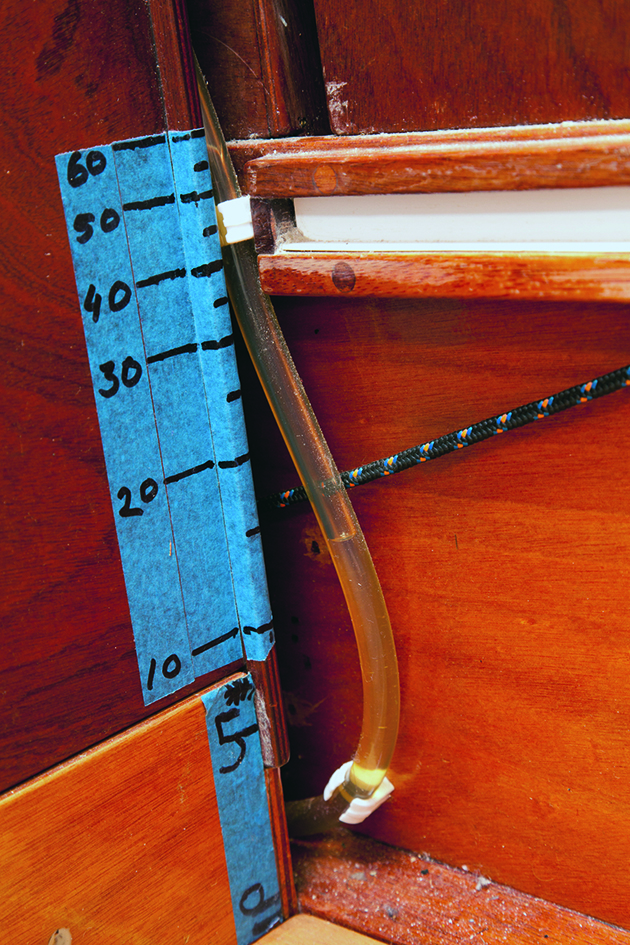
With the fuel tank being an irregular shape and tucked away out of sight, a gauge with a difference is needed. Credit: David Harding
Neat touches abound, from the extension to the galley seacock to avoid the need to lift any bunks to turn it on or off, to the blow-and-suck fuel gauge using clear plastic pipe that Willem developed because the fuel tank is both an irregular shape and tucked away out of sight abaft the galley.
To read the level, he blows through the end of the pipe that normally lives beneath the deckhead, then sucks to draw the fuel above the level of the tank before letting it settle and noting the reading against the calibrated marks.
Other ideas include mounting the water filter outside the engine compartment for ease of checking, a dedicated emergency battery for the VHF radio at gunwale level so communications can be maintained without recourse to a hand-held set should the ship’s batteries become flooded, and a semi-automatic switching system for the nav lights. This last idea is particularly neat.
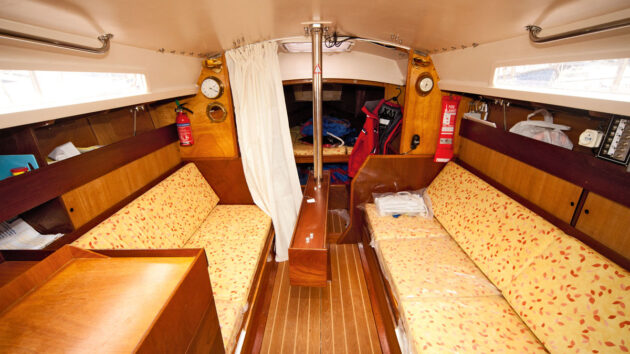
Four berths, a heads and galley – a perfectly respectable interior for a sporty 24-footer. Credit: David Harding
First, the main nav-light switch on the panel glows in the dark, so it’s easy to find.
Once it’s switched on, you move to the adjoining panel, which has three more toggle switches. The first switches between ‘anchor’ (for the anchor light) and ‘sail’. Flick it to sail, and you move to the next – tri-colour or bi-colour – so you can’t end up with the wrong combination and sail around lit up like a Christmas tree if your crew doesn’t know the form or follow your instructions.
Last in the row is the ‘steaming auto’ or ‘steaming manual’ switch: automatic so the steaming light comes on automatically in power mode, or manual for testing.
Power mode – steaming light, stern light and the bi-colour on the bow – is automatically engaged if the nav lights are on when the engine is turned on, so if you start motoring after dark, there’s no need to go below to switch the lights over.
Verdict on Waarschip 740
A good design, combined with a skilled and creative builder, has resulted in a great little boat in the Waarschip 740, Flotaxe.
Willem’s efforts would have been wasted had he not put them into building the right boat, but the Waarschip 740 has undoubtedly done them justice.
She’s conveniently small for coastal and short-handed sailing, yet with a power and performance that belies her modest size.
That much was obvious even in the gentle conditions of our test sail. Plywood is still a great material for building boats – particularly since the advent of epoxy resins.
Not only the preserve of designs created for home-building, it’s also chosen by builders such as Waarschip and by RM Yachts in France for professionally-built boats.
Besides, with most fibreglass designs, there comes a time when not enough are being built for the moulds to be worth preserving, and they’re chopped up.
That’s not a problem with plywood construction, which is why all the Waarschips are still available, either in kit form or ready-built.
Like Willem with his Waarschip 740, you can choose between the various models and do a bit of mix-and-match as you see fit. As well as the standard and Ocean versions, there’s a Sport for those who want to maximise the performance potential.
Nautisch Centrum Delfzijl in north-east Holland sells the 740 and the older models alongside a range of new designs, from the sportsboat-style 700LD to the oceangoing 1220.
Also in Delfzijl is Waarschip Werf, offering a different line-up of Waarschips that includes a 6.7m day-sailer at one end and the 1240 at the other.
If you’re looking for a second-hand example, you will find plenty to choose from, including a selection of 740s, since 200 or so have been built.
Just bear in mind that not all will be up to the standard of Flotaxe.
At PBO, we have rarely had occasion to write about Waarschips of any description.
It took a resourceful Dutch owner who built his own to introduce us to this range of boats that is less well known on these shores than it deserves to be.

